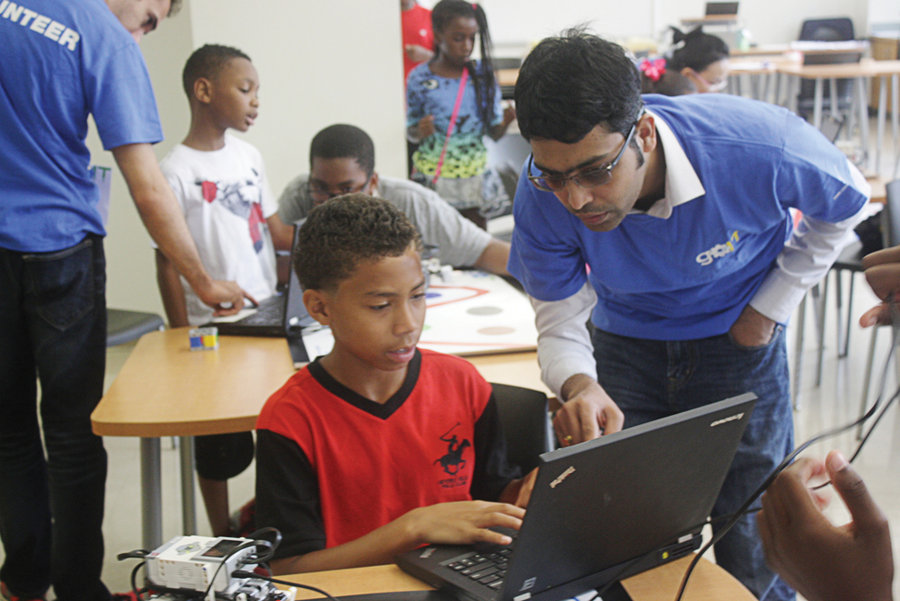For three days in July, kids from Jersey City and Bayonne took part in a unique program that allowed them to build, program, and race robotic cars. The event was designed to raise awareness and interest among students in science, technology, engineering, and mathematics (STEM), and concluded with a race on July 30 attended by representatives for U.S. Senators Robert Menendez and Cory Booker.
By 2023, jobs in science, technology, engineering, and mathematics are expected to greatly exceed the number of graduates who can fill them. Currently less than 2.5 percent of American students are seeking degrees in those areas.
For this reason, Tata Consultancy Services (TCS) is providing a program (goIT) that would encourage students to seek career paths in these areas.
The goIT student technology awareness program is intended to inspire students to pursue degrees and careers in STEM, and to magnify their critical thinking skills with hands-on activities like those just experienced by the students from Jersey City and Bayonne.
Since the program’s launch in 2009, goIT has engaged more than 8,800 middle and high school students across 93 schools. More than 70 percent of the students who participated in goIT reported an increased interest in STEM careers, and goIT participating schools reported a 27 percent increase in high school students choosing STEM disciplines in college. This year, TCS also hired its first graduate of the goIT program.
Janet Wallach, director of programming for the Boys and Girls Club, said the event was staffed by workers from Tata, who volunteered to oversee the induction of the kids.
While a few of the kids had some technology background coming into the three-day event, all came in with no preparation for this particular experience.
“They learned it all in the three days,” Wallach said. “Technology is huge in the world, and this really engaged them.”
A learning curve
Structured something like a summer camp, the event in three sessions trained the students how to construct a robot, then how to program it in order to compete in a race. There were about 20 kids in the program.
The program was designed to give the students a taste of technology and combine the various disciplines needed to make it work. Arif Rahman, tech specialist for STEM, said the three day program introduced students to robots, which allowed them to build Lego computer-operated race cars that came in kits with instruction books.
“They build the Legos on the first day,” Rahman said.
“They work in a group and build it as a team.” – Arif Rahman
____________
The kids worked three to a team. In many cases, each of the kids took on a specific role, such as taking the lead in construction of the vehicle, or programming and working with the vehicle on the track. All roles are steeped in mathematics, engineering and technology.
“They work in a group and build it as a team,” Rahman said.
The teammates collaborated to make sure the vehicle worked right and that the programming did what it was supposed to do.
The robot had color sensors which the kids had to program correctly for it to follow the course. Done wrong, the robot can simply spin around in circles or crash. Each robot is about the size of a hardcover text book.
The second day the kids learned basic computer coding. They learned to input the instructions into the computer that directed the robot during the competition. The robots have to follow a red line on a track that is several yards long and wide. The line curves one way and then the other.
There are actually two tracks to choose from, one that has the curved lines, another that looks a little like the board for a game of Twister. Before the race was conducted, organizers picked one or the other track depending on how well they think the kids would do on a particular track.
While the Lego robotic cars can be operated from the computer by Bluetooth or WiFi, Rahman said, they hard wired these cars via USB because of the reliability of the connection.
Team work counts
There were seven teams made up of kids from Jersey City and Bayonne.
Isha Sidibay, a 6th grader from Jersey City, teamed up with Dallasia Samuels for an all-girl tech team.
“We had some trouble building the Lego,” Sidibay said. “We mixed up the parts.”
Once constructed, however, this team seemed to take off as they programmed the car for a pre-set number of wheel rotations.
Sidibay said she is very good in arts and believes this program might help her eventually learned to design a vehicle in future.
Samuels said she would like to be a veterinarian, where technology has already made inroads such as robotic surgery.
A team of three boys from Jersey City were working hard to get past a programming problem. While they got their car to travel most of the track, it kept coming to a halt around the last curve.
They had worked out their roles on the team. Tyrone Turner did a lot of the directing, Elijah Young did programming, and Bryce Barnes did most of the construction.
Unlike other teams, Barnes said construction was pretty simple. Barnes, who is going into 7th grade, said he intends to pursue a career in marketing. But he said he picked up on this project pretty quickly. All three were distracted by the programming problem.
“We can steer it, but it keeps getting stuck on that one turn,” a frustrated Young said.
Are they going to win the race?
“You bet,” said the confident Barnes, as they all turned back to the task.
Al Sullivan may be reached at asullivan@hudsonreporter.com.
